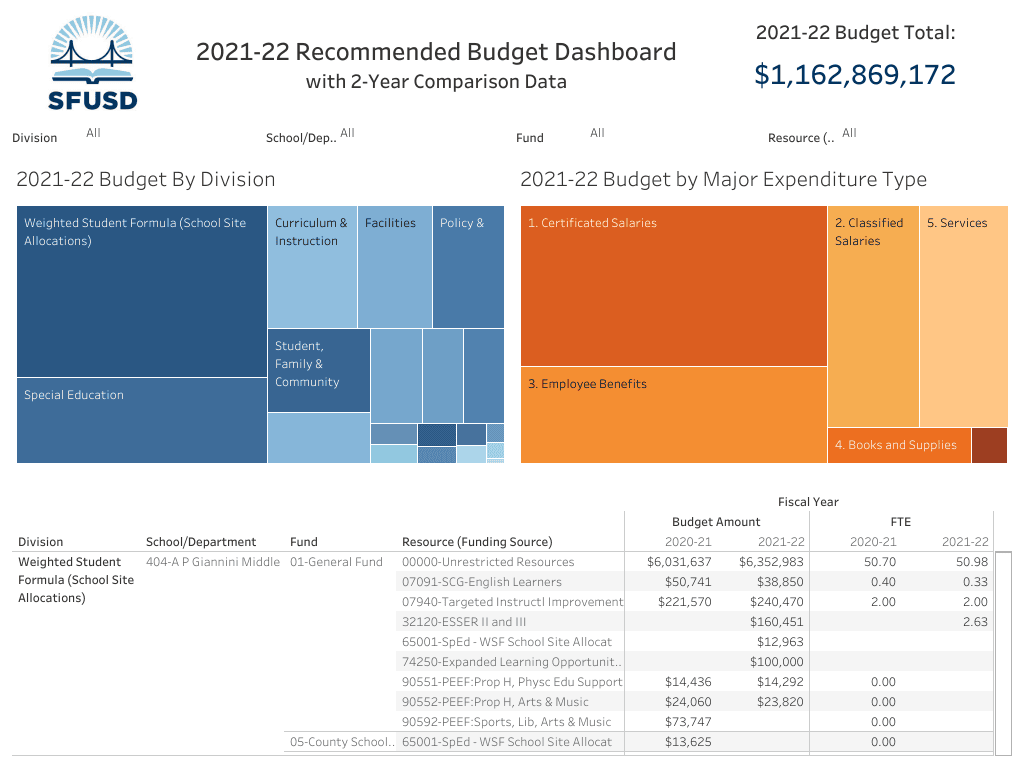[ad_1]
by Daphne Young
Shortly before the July 1 deadline, the San Francisco Board of Education unanimously approved the $ 1.16 billion budget for the 2021-22 school year.
SFUSD expects to receive $ 140 million in federal grants that will help welcome its students with increased academic and health support this fall, and help address the district’s $ 100.2 million budget deficit.
“We are incredibly grateful to the San Francisco voters who have consistently shown their support for public education,” said Gabriela Lopez, president of the SF Education Committee. “Thanks to their generosity, our public schools offer more arts and music, physical education, library services and student support than any other major urban school district in the state,†added Lopez.
Because of PEEF, every school in the San Francisco Unified School District (SFUSD) has a library and a certified librarian, and every student has access to a nurse or social worker.
SFUSD had a July 1 deadline to send its approved budget, which included the Public Education Enrichment Fund (PEEF) 2021-22 spending plan of $ 75.8 million, to the state of California. This voter-approved spending plan supports many programs in the city’s public schools, including sports, library, arts, and music programs.
Because of PEEF, every school in the San Francisco Unified School District (SFUSD) has a library and a certified librarian, and every student has access to a nurse or social worker. “It has never been more important to be at the forefront of delivering school wellness programs,” said Education Committee President Lopez.
To get some background on PEEF, the Public Education Enrichment Fund was created after San Francisco voters passed a constitutional amendment in 2004 to provide tax money to supplement programs in the city’s public schools. The fund was re-authorized by San Francisco voters in 2014 to extend PEEF through 2041.
The newly approved budget approved by the SFUSD Board also includes $ 93.5 million in package taxes from the Quality Teacher and Education Act (QTEA), approved by San Francisco voters in 2008, and the Fair Wages for Educators Act (FWEA ), which was approved by San Francisco approved voters in 2020.

Both measures help make teacher salaries in San Francisco competitive with those in the surrounding school districts. The measures also provide financial incentives for teachers to work in schools with historically high turnover and to teach hard-to-fill subjects such as mathematics in high school.
“As we get out of the pandemic and prepare to have all students return to face-to-face learning in the fall, we are prioritizing programs for our students with the greatest need,” said SFUSD Superintendent Dr. Vincent Matthews. “We are very excited about the federal funding and government grants as our costs have continued to rise,” he added.
“This is a much needed short term tool to support and stabilize our students as they return from distance learning and the challenges related to the pandemic. While we are ready to do as much as possible for the students this year, we are still working on a multi-year plan to balance our budget, â€said Matthews.
Meghan Wallace, SFUSD’s Chief Financial Officer, tells us that “To overcome this fiscal cliff, the district staff will continue to work with zero-based budgeting to find a path to sustainability in public finances over the next five months “.
Every year parents, students, work partners and community members are given the opportunity to provide feedback and help shape SFUSD’s local control and accountability plans (LCAPs).
Wallace continues in a statement issued by SFUSD: “By allowing an additional year to maintain our investment in our students, this is overshadowed by the short-term nature of several major funding sources and an impending deficit of $ 112 million in FY2022. 23. ”
The zero-based budget process aims to prioritize district spending into three categories: basic package services, district priorities, and service improvements. Wallace said budget cuts would be made by scaling back service improvements and finding ways to make the delivery of basic package and district priority services more efficient.
However, school district officials also warn that the new state and federal funding may only provide short-term relief for an ongoing structural deficit that SFUSD and many other California school districts are facing.
Even before the pandemic began, SFUSD revenues grew slowly, while the cost of running the seventh largest school district in one of the state’s most expensive, but poor, cities grew exponentially and the fund balance fell. Also, with school closings and the introduction of distance learning to curb the spread of COVID-19, SFUSD struggled to cope with the education crisis with limited resources.
In addition, school districts must adopt Local Control and Accountability Plans (LCAPs) that show how the districts will spend the additional funds to support their high-need students. Every year parents, students, work partners and community members have the opportunity to provide feedback and help shape the SFUSD LCAP.

California’s LCFF (Local Control Funding Formula), passed in 2013-14, replaced the previous kindergarten with the funding method for the 12th income limit and percentages of high need students they serve.
The district’s budget also reflects an increase in state funding: SFUSD expects $ 551.3 million from the Local Control Funding Formula (LCFF), California’s premier source of state education funding. These funds in SFUSD’s unrestricted general fund are an increase of $ 20 million, or 3.8 percent, over the previous year. The bulk of SFUSD’s total operating budget is made up of the Unrestricted General Fund, which includes funds for educational support such as employee salaries and benefits.
The next largest share of the budget, the Restricted General Fund, is 38 percent of the total budget. Limited funds may only be used for specific purposes, such as PEEF and the Quality Teacher and Education Act (QTEA), which helps fund higher pay and professional learning for educators.
What parents need to know is that a “full reopening plan and budget” had to be agreed and approved by the board in order for SFUSD to receive the various funds mentioned above. And while many parents may disagree with some elements of SFUSD’s reopening plan for Fall 2021-22, some kind of cohesive plan along with a budget was required for SFUSD to receive grants and funding offered by the state for the upcoming school year.
For more information on the short-term SFUSD budget for 2021-22, please visit sfusd.org.
Daphne Young is an education reporter for the San Francisco Bay View National Black Newspaper. The Chicago native is an award-winning journalist who reports news for radio and television stations across the country. She attended San Francisco State University and is a member of Delta Sigma Theta Sorority, Inc. If you have an educational story you would like to see on the cover of Bay View, please email Daphne: [email protected].
[ad_2]

